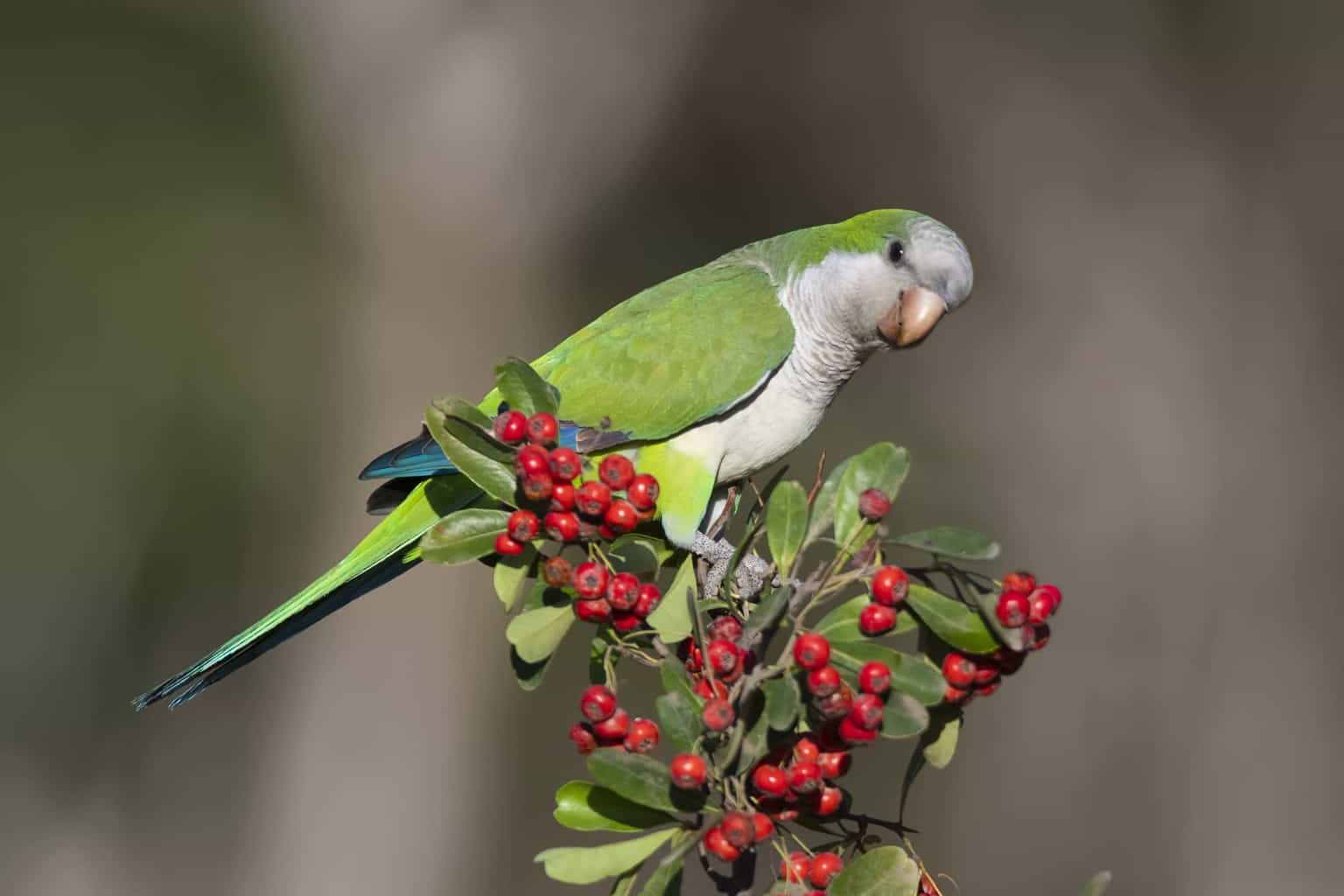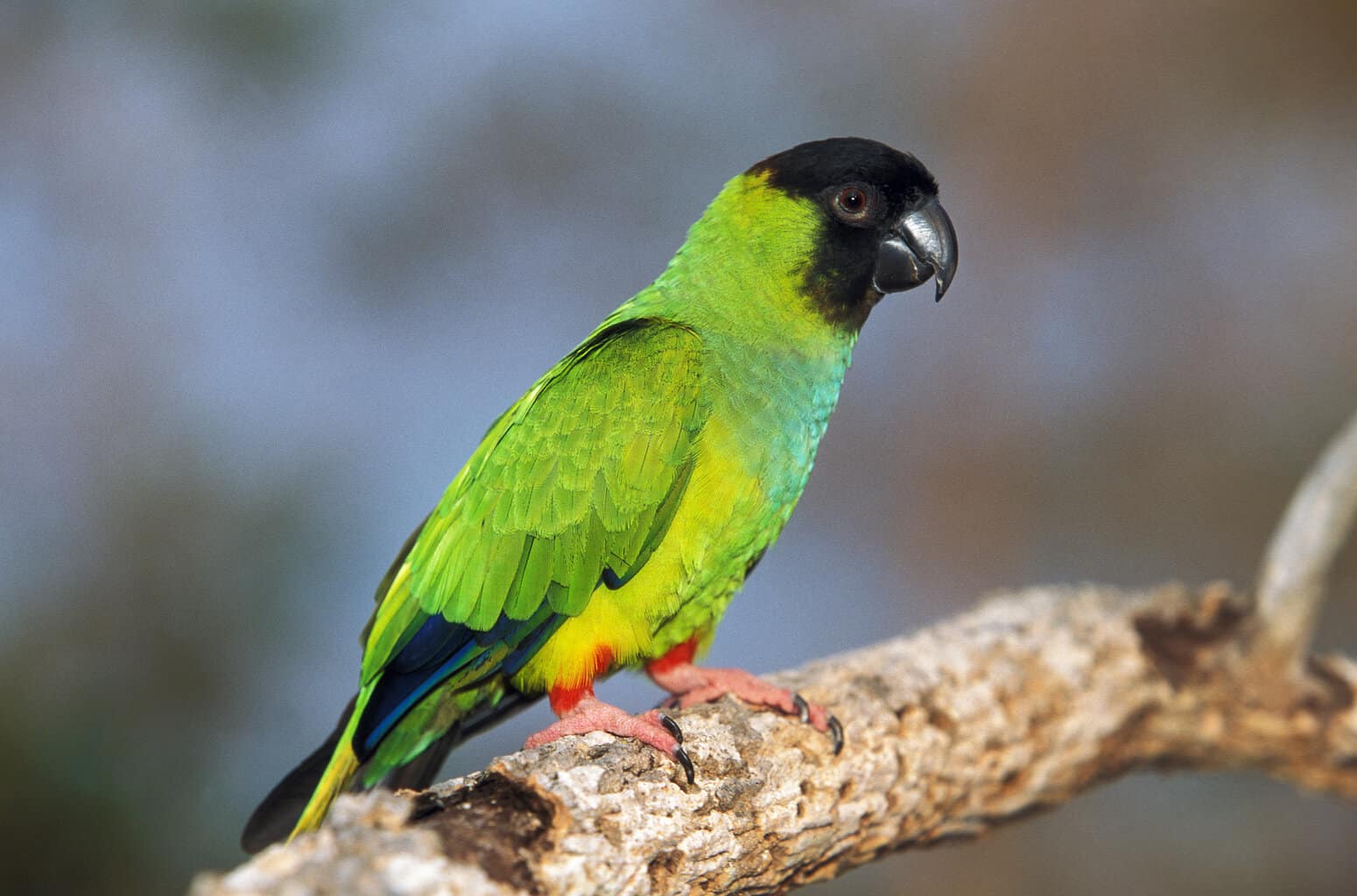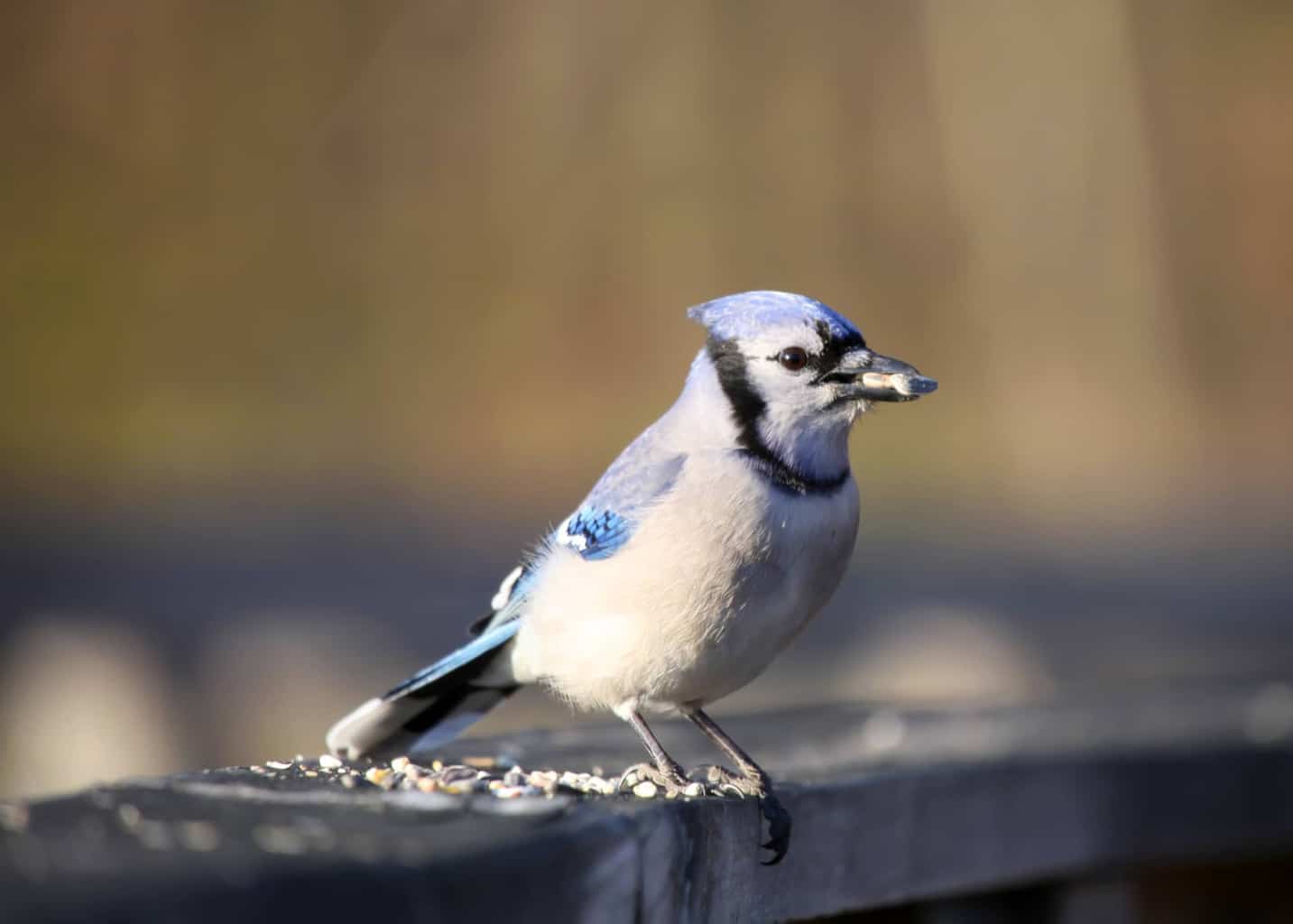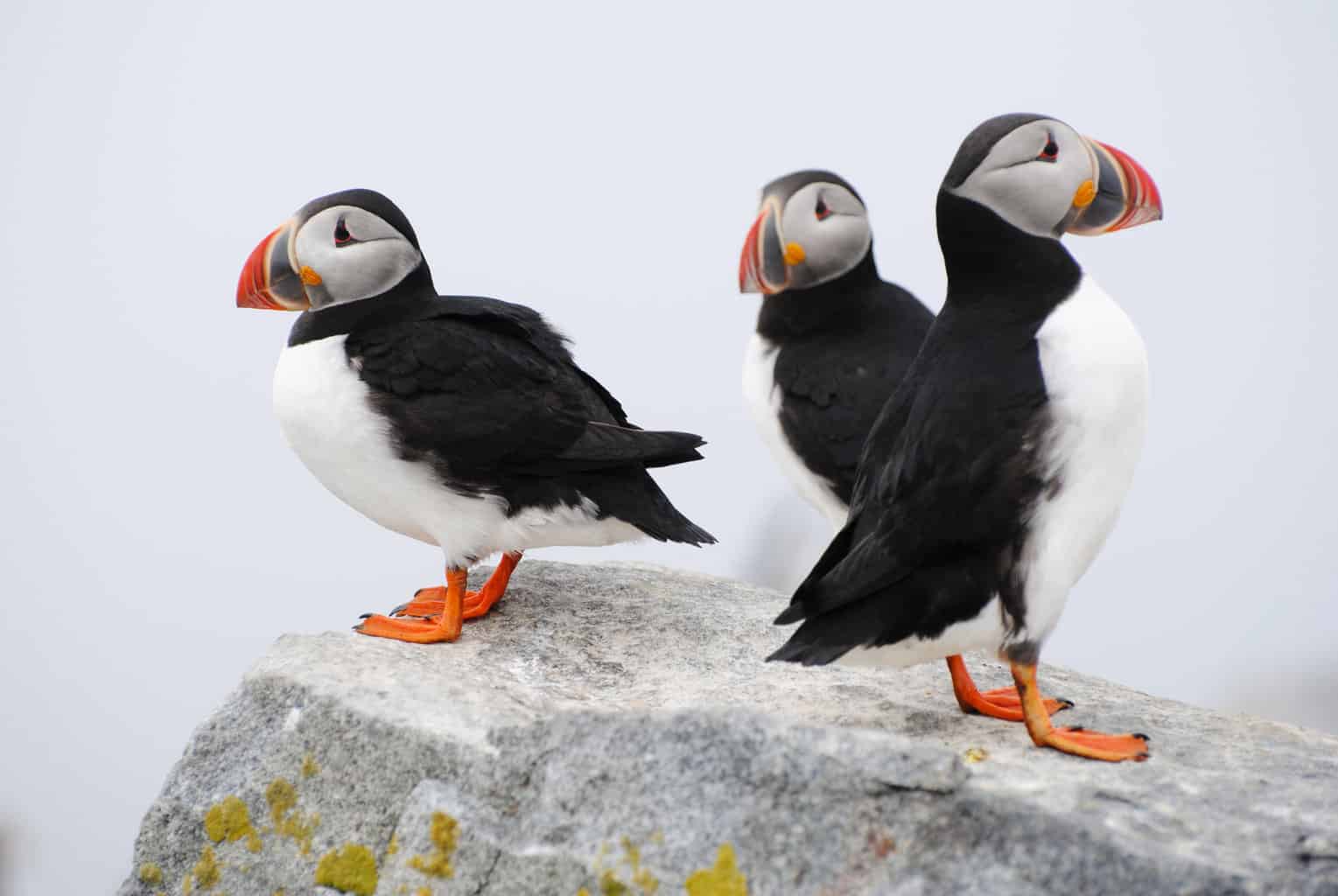Have you seen a parrot where you live? Or a lookalike species?
What Are Parrots?
Parrots, also known as psittacines, are birds within 92 genera, around 398 species in total, that belong to the order Psittaciformes.
Mostly found in subtropical and tropical regions, there are three groups within this order. There are the Psittacoidea (also known as ‘true parrots’), the Cacatuoidea (cockatoos), and the Strigopoidea (New Zealand parrots). The greatest variety of parrots is found in South America and Australasia.
Macaws, Amazons, lorikeets, lovebirds, cockatoos, and many others are all part of this bird order and are considered to be parrots.
Sadly, around a third of all parrot species are threatened by extinction, and many are on the IUCN Red List. As of 2021, around half of all parrots alive on our planet live in captivity – the vast majority of that half are kept as pets in peoples’ homes.
It is believed that parrots evolved in Gondwana, centered in Australasia, around 59 million years ago. The three major groups of parrots originated around 50 million years ago.
Genomic evidence suggests that these birds are most closely related to the group of birds known as passerines and form the Psittacopasserae clade with them. This is the sister group of the falcons (Falconiformes).
What Do Parrots Look Like?
Parrots can have a range of sizes, and their plumage can vary in color and pattern.
Living species range in size from the buff-faced pygmy parrot, at under 10 grams (0.4 ounces) in weight and 8 centimeters (3.1 inches) in length, to the hyacinth macaw, at one meter (3.3 feet) in length, and the kakapo, at 4 kilograms (8.8 pounds) in weight.
But many parrots share certain key characteristics.
For example, they tend to have strong, curved bills. Their stance tends to be upright, and they have strong legs and clawed zygodactyl feet (with two toes facing forward and two backward). Many parrots are very brightly colored, and males and females typically look alike.
Parrots are the only creatures in the world that exhibit true tripedalism – in other words, they use their necks and beaks as limbs, and these are just as strong as the forelimbs of primates used when climbing vertical surfaces.
Some Wild Parrots Seen in North America
Red-Crowned Parrot (Amazona viridigenalis)

- Length: 13.0 inches (33 centimeters)
- Weight: 11.2 ounces (316 grams)
- Wingspan: 25.0 inches (63.5 centimeters)
Native to a small region of northeastern Mexico and perhaps southern Texas, these parrots have also escaped from captivity and set up breeding populations in some large cities. This is a fairly large parrot with a blocky head and thick neck. They are leaf green with a prominent red patch on the top of their heads and red patches in their wing secondaries that are visible when the birds are in flight.
Monk Parakeet (Myiopsitta monachus)

- Length: 11 inches (29 centimeters)
- Weight: 3.5 ounces (100 grams)
- Wingspan: 19 inches (48 centimeters)
Though native to south American grasslands, Monk parakeets can be seen having escaped from captivity in several US cities, such as New York, Chicago, Portland, Oregon, San Diego, Houston, Dallas, New Orleans, and Miami. This is the most abundant naturalized parrot species in the US. These birds are green, with gray fronts, a touch of blue on folded wings, and pinkish-orange bills.
Green Parakeet (Psittacara holochlorus)

- Length: 28-30 centimeters (11-12 inches)
- Weight: 227 grams (8 ounces)
- Wingspan: 19 inches (48 centimeters)
Green parakeets occasionally extend their range into southern Texas and could be considered native to this small corner of the US. But native or not, these can also sometimes be seen as feral escapees elsewhere. These are green parrots with lighter green fronts and pinkish bills.
Nanday Parakeet

- Length: 27–30 centimeters (11–12 inches)
- Weight: 140 grams (4.9 ounces)
- Wingspan: 22 to 24 inches
Native to the wetlands of the Pantanal region in Central South America, these can be seen throughout central and southern Florida, in California around Los Angeles and Orange County, and sometimes in Arizona and Texas. They have yellow-green bodies, bluish-black wings, and distinctive dark heads and bills. They also have bracelets of red feathers around the base of their legs.
Monk parakeets, Red-crowned parrots, and Nanday parakeets make up 61% of all sightings of parrot species in the US reported on eBird and CBC over the last 15 years.
But other parrots are present in specific locations, and many other species are sometimes seen.
For example, Miami is particularly famous for its resident flock of more than 20 Blue-and-gold Macaws. In Phoenix, Rosy-faced lovebirds can be seen.
And since a documentary of 2003, ‘The Wild Parrots of Telegraph Hill,’ a flock of Red-masked parakeets in San Francisco are also well known. (Though sadly, the 300-strong flock is currently endangered by rat poison set out to control rodents in the city.)
Los Angeles, San Francisco, and San Diego all have populations of Red-masked Parakeets, Yellow-chevroned Parakeets, Blue-crowned Parakeets, and Rose-ringed Parakeets, among others.
US Birds That Look Like Parrots
Cardinalidae

Cardinals is a term that applies broadly to Cardinalidae, birds within a family of new-world endemic passerine birds. The term also refers more precisely to the Northern cardinal, and another cardinal, known as the Pyrroxia, is also sometimes found in the southernmost reaches of the southwest.
The brilliant hues of Northern cardinals, several tanagers, grosbeaks, and buntings, may make us think of parrots. Perhaps most of all, the very colorful Painted bunting, Passerina ciris.
These birds are found in the coastal southeast and the south-central US. The males have blue, green, yellow, and red plumage, and the females and juvenile birds are bright green with pale eye rings. However, these have many anatomical differences compared to parrots that might be seen in the US and are much smaller. They have stubby, grayish seed-eating bills.
Corvidae

Corvids like jays, crows, and magpies are, like parrots, among the most intelligent birds, with amazing powers of vocalization and mimicry. Colorful species like Blue jays and Steller’s jays may share a parrot’s flamboyance but have few real visual similarities.
Perhaps the bird most reminiscent of parrots is the much rarer Green jay, seen only in the very far south of Texas in the US. They have a rich green on their backs, yellow on the front, blue crowns, black on their throats and around their eyes, and yellow outer tail feathers.
Trogonidae

Many different trogons live in tropical forests, but only one, the elegant trogon (Trogon elegans), can be seen in the US, and even then, only in a very small area of the Arizona southern mountain ranges.
With short, stout bodies and square tails, these birds resemble parrots in their bright coloration. The males have red bellies, white chest bands, dark green heads and backs, distinctive reddish rings around their eyes, and yellow bills. Females are gray, with russet on their lower bellies.
Fringillidae

Finches and crossbills in the US do not usually have coloration as vivid and distinctive as a parrot, though some, like the Red crossbill, are quite colorful and have distinctive hooked bills that can look rather like those of certain parrots in shape.
But in Australia, there are Gouldian, or Rainbow finches, which have parrot-like coloration and parrot-like bills, and certainly look a lot more like parrots.
Hook Billed Kite
Though this is an unrelated bird in the Accipitridae family, the Hook-billed kite is a distinctive raptor that, although it does not look like a parrot in other ways, has a similar bill. Some individuals of this species make it from South and Central America to southern Texas along the Rio Grande.
Puffins: ‘Parrots of the Sea’

Puffins are brightly colored and have distinctive short, curved bills like parrots. For this reason, they are often called ‘parrots of the sea.’ Though it would be difficult to actually mistake a puffin for a parrot, they do share these small similarities.
Of course, elsewhere in the world, there are plenty of other birds that resemble parrot family members to some degree, such as the birds of paradise, for example, and a range of kingfishers, which can also be very brightly colored.
But in the US, while feral wild parrots can be difficult to distinguish from one another, it is unlikely that they will be mistaken for any native species in the areas where they are found.

